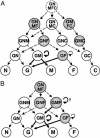Self-renewal capacity is a widespread property of various types of neural crest precursor cells
- PMID: 15070746
- PMCID: PMC384775
- DOI: 10.1073/pnas.0400629101
Self-renewal capacity is a widespread property of various types of neural crest precursor cells
Abstract
In vertebrates, trunk neural crest (NC) generates glia, neurons, and melanocytes. In addition, it yields mesectodermal derivatives (connective tissues, chondrocytes, and myofibroblasts lining the blood vessels) in the head. Previous in vitro clonal analyses of avian NC cells unraveled a hierarchical succession of highly pluripotent, followed by various intermediate, progenitors, suggesting a model of progressive restrictions in the multiple potentialities of a totipotent stem cell, as prevails in the hematopoietic system. However, which progenitors are able to self-renew within the hierarchy of the NC lineages is still undetermined. Here, we explored further the stem cell properties of quail NC cells by means of in vitro serial subcloning. We identified types of multipotent and oligopotent NC progenitors that differ in their developmental repertoire, ability to self-maintain, and response to exogenous endothelin 3 according to their truncal or cephalic origin. The most striking result is that bipotent progenitors are endowed with self-renewal properties. Thus glia-melanocyte and glia-myofibroblast progenitors behave like stem cells in that they are able both to self-renew and generate a restricted progeny. In our culture conditions, glia-myofibroblast precursors display a modest capacity to self-renew, whereas glia-melanocyte precursors respond to endothelin 3 by extensive self-renewal. These findings may explain the etiology of certain multiphenotypic NC-derived tumors in humans. Moreover, the presence of multiple stem cell phenotypes along the NC-derived lineages may account for the rarity of the "totipotent NC stem cell" and may be related to the large variety and widespread dispersion of NC derivatives throughout the body.
Figures




References
-
- Le Douarin, N. M. (1982) The Neural Crest (Cambridge Univ. Press, Cambridge).
-
- Le Douarin, N. M. & Kalcheim, C. (1999) The Neural Crest (Cambridge Univ. Press, New York), 2nd Ed..
-
- Etchevers, H. C., Vincent, C., Le Douarin, N. M. & Couly, G. F. (2001) Development (Cambridge, U.K.) 128, 1059–1068. - PubMed
-
- Sieber-Blum, M. & Cohen, A. M. (1980) Dev. Biol. 80, 96–106. - PubMed
-
- Sieber-Blum, M. (1989) Science 243, 1608–1611. - PubMed
Publication types
MeSH terms
LinkOut - more resources
Full Text Sources
Other Literature Sources
Medical

